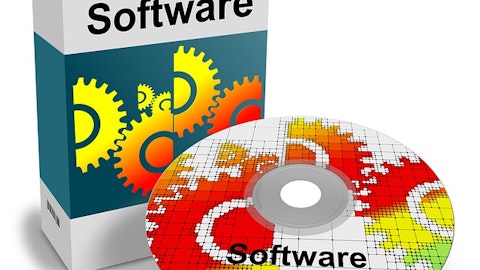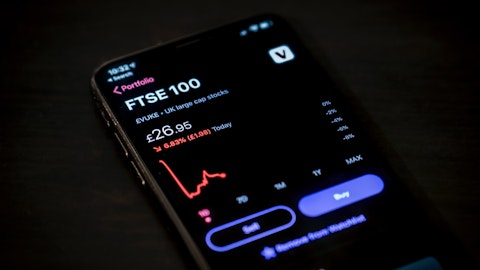But the characterization of how your really great Braze partner is very different from the way that you may have been a great partner of the legacy marketing clouds. Braze represents easier integration, faster time to value. But on the flip side, it also represents greater opportunities to compound ROI through experimentation, through additional data analysis. And so the types of services that really resonate with the Braze customer base are different from what the GSIs were maybe used to providing for legacy marketing cloud providers. They’re better, and they’re exactly where those partners are trying to evolve to, because it represents more ongoing revenue as opposed to being predominantly the upfront integration-oriented revenue. And so it’s definitely an evolution that our partners want to make, especially at the GSI level.
It’s one that we’re supporting them and making. But as I mentioned, they’re certainly progressing at different speeds, depending on how leaned in those organizations are. And we’re looking forward to seeing the success that we are in all the places where partners are really leaned in, where they’ve adapted their model to spread more evenly across that entire ecosystem over time. And we’re investing internally to make sure that’s going to happen. So we’re seeing really promising early results from the GSIs and from the big holding companies, we’re seeing growing momentum quarter-over-quarter. And like I said, we have complete confidence that the foundations of how we get that flywheel spinning in a mutually beneficial way are completely sound and will continue to be.
And we’re excited about where that’s going.
Operator: Our next question comes from Michael Berg with Wells Fargo.
Michael Berg: Congrats on quarter. I just have a quick one on the cloud data adjustment progress. You have a number of announcements in and around that space. And with the strength you’re seeing in the business, maybe you can help us understand how that’s helping either drive expansion, stickiness adoption, or how you’re thinking about the benefits of that longer term? It certainly seems it can ease the adoption curve here.
Bill Magnuson: Yes, I think that’s exactly right. And broadly, we are focused on ensuring that our customers can get their data into Braze quickly, easily, affordably and that they can do so without an ongoing maintenance burden. And so when you think about whether you want to call it the total cost of ownership or just think about the characterization of how Braze first deploys and then lives within a technology ecosystem. What we’re trying to do with things like cloud data ingestion is the activation energy to both, get data flowing into Braze in the first place, but also to add those incremental use cases over time. And so that ability to onboard a customer more quickly to have them get comfortable in the Braze environment, get their early use cases out the door and then immediately be looking at new opportunities to say, “Hey, oh, I didn’t anticipate that I might want to personalize with this particular bit of data,” or “My data science team has just completed these new machine learning models around propensity scoring.
That would be really helpful to incorporate into my personalization strategies in Braze,” or “I have a new corporate KPI that I want to be able to measure that was not a conversion event that was in my initial integration, but it lives in my data warehouse.” There’s a lot of examples like these that in the past, our marketing team would have had to have gone to an engineering team or a data science team, gotten into their next sprint cycle, gone through all of the heavyweight machinery that goes into releases around new software and such and just leads to delays additional energy and investment required. And often, that’s enough for them to get their progress blocked up. And so what we’re really trying to do is put marketers in control of their own destiny for a wider swath of the data that lives within their ecosystem.
We’re committed to giving customers flexible options for our stream processor to ingest either their raw data, the insights that they’re generating through additional data science work, and obviously, all of the events and other activities that are generated by end user actions. And that means that we’re committed to continuing to integrate with our whole partner ecosystem, working with CDPs, with reverse ETL vendors, with various analytics software as well as the data warehouses and lake houses and our own customers bespoke data engineering pipeline. So you should expect to continue to see a broad investment by Braze on the data front, so that the Braze data platform continues to allow our customers to both, get up and running more quickly, get more use cases to us.
And we’re not trying to monetize things like that independently because, of course, we have the great advantage of new data that flows into Braze drives more use cases. It leads to incremental monthly active users when people bring in new user populations, and it leads to additional messaging usage as people start to deploy Braze into more and more parts of their user journey. And so we really look at data as an input. We want to make sure that customers can get it into Brazes very easily, they can expand that over time. And it’s all a really good self-reinforcing loop for us.
Michael Berg: Very helpful. And then a quick follow-up on the product front. Generative AI, you mentioned you were early to the game. When I think about your Data [indiscernible] platform, it certainly seems like the products are coming out at a pretty high velocity. Is there anything structural in either your architecture or how you’re using generative AI that’s helping with your R&D velocity? And do you feel that’s a competitive advantage moving forward to help take further share from the legacy players?
Bill Magnuson: Yes, absolutely. I mean especially when comparing to the legacy players, many of which were assembled through a series of acquisitions and still maintain the siloed architectures that come as a result of that. I think Braze has always been super focused on keeping tight vertical integration through all the different layers of our stack as well as just keeping complexity under control, making sure that we’re constantly upgrading our foundations or we’re keeping tech under control. A lot of the things that keep a well honed and the sharing machine running at high velocity even as you continue to scale. And so when we’re — when we look at the roadmap velocity, we’ve been really happy with it for years. We’ve continued to add more and more investment to our R&D teams.
And unlike in a lot of companies, as they get to a certain scale, you start to see the unit productivity slowdown out of R&D. I actually feel like in many ways, because of the strengthening of the foundations of Braze, we’ve sped up our unit productivity over the last few years. And you’re seeing the results of that as see not only the rapid injection of AI into more and more of our platform, but you’re also seeing channel expansion, platform expansion, the Braze data platform continuing to deepen its capabilities. And as we think about where the future of customer engagement is going, what we’re trying to do is make sure that we’re supporting exactly where the leading edge of modern customer engagement teams are driving towards. They’re becoming responsible for more and more of the customer journey.
They’re becoming responsible for not just the delivery of marketing messages but also aspects of the product experience. And those are all the leading edge of where we think that you can bring in a lot of these ideas around: How are we data driven about what we’re delivering? How do we use agility and experimentation to compound learnings over time? How do we make sure that we’re delivering personalized and relevant experiences where we can take in the combination of all the context around the customer, all of the strategies and the important priorities for our business, and we combine those with automated decision-making through all the investments in AI and ML? And those things compound together to create a tremendous amount of value for the brands that use Braze.
They also deliver better product experiences to end-user customers. And so we’ve always looked at the importance of us controlling that end-to-end data flow. And when you think about Braze’s vertical integration where we live inside the end-user products, as users take actions, we know about it immediately. We’re able to respond to it in the moment, in the product or we’re able to use those insights in order to inform subsequent actions. And marketers are able to actually stay focused on business strategy as opposed to thinking about channels. And so that’s all inherent to our architecture. It’s been there from the very beginning. And you’re seeing the benefits of that, not just in our great growth as a company but also in our R&D velocity.
Operator: Our next question comes from DJ Hynes with Canaccord.



